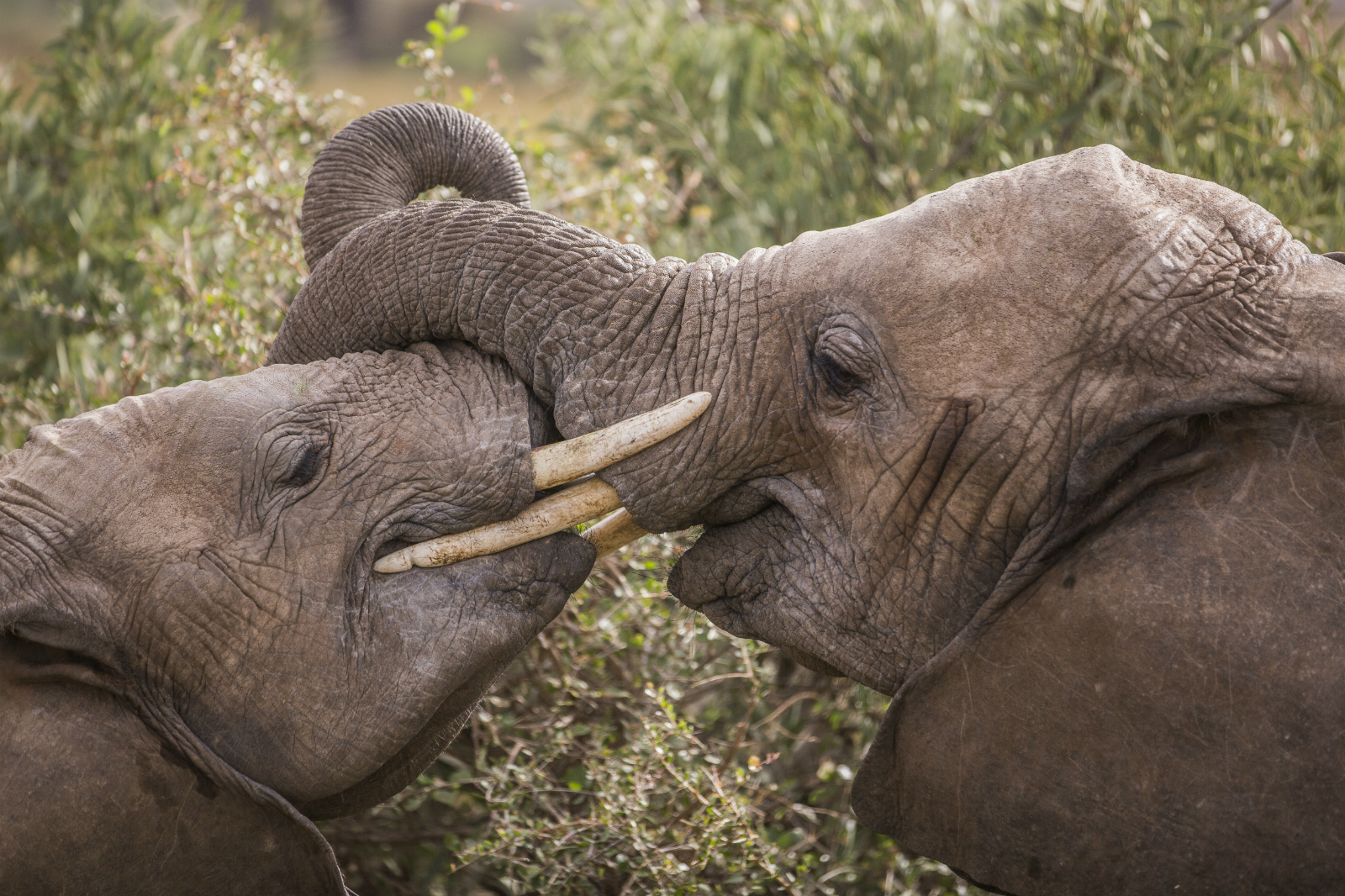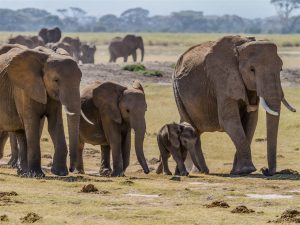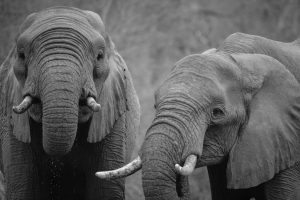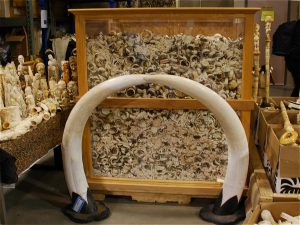Credit: Photos have been republished from the Guardian with permission.
In the Samburu National Reserve in northern Kenya, when the fierce heat of the sun has softened into a gentle evening glow, David Daballen and I climb into a jeep to find some elephants.
As we drive through the savannah, Daballen, a conservationist at Save the Elephants, points out family groups and individuals within them. “These are the Butterflies, this group is Storms, here are the Spices,” he says. We have been looking out for Cinnamon, the Spices’ matriarch, and suddenly there she is: around 50 years old, huge and tuskless, having been born without any precious ivory. Close to her is Habiba, who was orphaned along with seven siblings when poachers killed their mother in 2011. The orphans were adopted by Cinnamon and the rest of the Spices.
Daballen reckons he can identify and name between 400 and 500 elephants. In the jeep, he keeps up a stream of names. “That’s Jonathan,” he says as we spot an elephant’s rear end, some 50 metres away. How can he tell one from another? “Look at their ear patterns: the nicks and holes and tears. Look at their tusks: some are short, some are long, some are curved, some are straight. Look at the pigmentation: some have pink skin, some are light, some are dark. But also look at their faces. They are like our faces, every one is individual.” It’s not just physical characteristics that are distinguishing, he adds. “When you spend time with elephants you understand they all have different personalities. They get into your mind. I probably know more elephants than people.”
One of Daballen’s colleagues tells me later that the recognition and respect is mutual. “The elephants trust him, they will come to him,” she says. Indeed, one evening our jeep, parked with the engine switched off, is surrounded by a dozen elephants, nudging against the vehicle, trunks nosing almost under our tyres to find clumps of grass, their eyes slowly blinking as they meet ours. It’s a magical moment.
After the group moves on, we drive back though near-darkness without headlights. Daballen navigates the jeep between thorn bushes and over furrows, guided by a rising moon and his intimate knowledge of the terrain.
At 36, Daballen has spent 16 years working for Save the Elephants (STE), and the 20 years before that living among them and other wild animals in the village of Marsabit, some 200km north of Samburu. When he was a child, he tells me, “there were a huge number of elephants up there, but they’ve been devastated by poaching.”
He would often encounter the animals walking to and from school, or while herding his father’s cows and goats. “Every other day we would be chased by elephants. At first it was frightening, and then it became a game,” he recalls. “I grew up close to them. Wildlife was part of us, part of our lives.”
After finishing high school, he went to join his older brother, who was by then working for the Kenya Wildlife Service in Samburu. One day Daballen saw a jeep with a Save the Elephants logo on the side. Curious, he discovered the organisation researched elephants – how they live, and how they die.
They are a crucial part of the ecosystem, and an iconic species. Can you imagine them no longer existing?
“I asked if I could intern with them. Then it was just two tents and a vehicle – almost nothing. I spent two months with them, then two months became four months, and four months became a year, and then they never let me go.” Now, he adds, “I think it’s very likely I’ll spend my life doing this.”
During Daballen’s time at STE, the tents have become a cluster of rudimentary eco offices, communal areas for meeting and eating, and cabins for sleeping. The one vehicle has become a fleet of battered jeeps and a Cessna 185 for aerial surveillance and transport across the vast tracts of savannah and hills in northern Kenya. Daballen the intern has become head of field operations, and an eloquent ambassador for the elephants of Samburu.
Back at the research station, he elaborates on his love of the creatures. “I’ve learnt so many things from them. The love and compassion they have for one another. Human love is very conditional, but theirs is unconditional. They are so close, they really care for one another – better than humans in many ways. The energy and excitement they show when they meet family members, even after a short period. It’s like they’re saying, ‘oh my god, where have you been?’ They are clever, intelligent creatures. They can navigate over huge distances and remember their routes and safe places. They mourn their dead. They are a crucial part of the ecosystem, and an iconic species. Can you imagine them no longer existing?”
A losing battle
Two or three years ago it seemed as though that could actually happen: future generations of Kenyan school children might only know about elephants from books and a collective memory. “We were all in desperation,” says Iain Douglas-Hamilton, veteran zoologist and founder of Save the Elephants. “We were losing the battle.”
It was just before sunset on 30 March 2014 when a volley of rapid gunfire shattered the stillness of the savannah. A phone call from the rangers’ commander quickly followed. His message: poachers are shooting elephants, bring reinforcements.
Daballen and his colleagues immediately rushed to STE’s research camp in Samburu. As the word spread quickly through the wildlife protection network, rangers and anti-poachers from the local community gathered, ready to help. Among them was Chris Leadismo, the organisation’s military-trained security liaison officer.
Leadismo and six others, armed with G3 automatic rifles, headed south. Knowing the poachers would hear the vehicles approach, they left their jeep on a dirt road and continued in silence, pausing periodically to listen.
“The rangers were crawling through the grass, inching forward, lying still, taking one more step, lying still. It’s a game of who sees who first – and it was now getting dark,” says Daballen. Two groups of heavily armed men, a herd of threatened elephants, poor visibility; danger was all around.
The poachers had separated a big bull elephant with long valuable tusks from the females. As the terrified females fled, another six shots rang out. “The rangers could hear the bull making death sounds – a loud rumble. Then they saw him. He was standing, but barely,” says Daballen.
Using night vision binoculars, Leadismo could see blood pouring from the bullet wounds in the elephant’s head and body. “He was full of blood, it was everywhere,” he says.
The rangers could hear the bull making death sounds – a loud rumble
The poachers and the rangers were aware of each other’s presence and knew that any movement could start a gunfight. The night crept on in wary limbo.
“The guys are lying on the ground in pitch black, not moving, not talking, no torches – nothing,” says Daballen. “It’s very dangerous out there at night. Then suddenly one of the rangers was bitten by a scorpion, and he cried out. That was the poachers’ luck.” In the commotion and darkness, the villains made their escape.
By then, Koitelel, a 30-year-old elephant, was dead with 16 bullet wounds in his carcass. The rangers carefully removed his tusks for safe storage and left his body for the hyenas.
Now, two years later, Koitelel’s bleached skull and bones still lie scattered amid the thorn bushes, a poignant memorial to an Africa-wide orgy of elephant killing, which some believe is threatening the very survival of the species.
Across the continent, elephant poaching is happening on an industrial scale. According to the shocking results of one study, released today, the population of savannah elephants declined by 30% between 2007 and 2014. There are roughly 400,000 savannah elephants left and that number is falling by 8% per year.
Vulcan’s* Great Elephant Census gathered detailed statistics over two years by flying over and counting herds of elephants as they roam the plains beneath. Dead elephants are counted too. A “carcass rate” (the ratio of living to dead) of more than 8% indicates poaching at a high enough level to cause the population to decline. In Mozambique and Angola, the rate was more than 30%. Among Cameroon’s small elephant herd it was 83%.
Other research has come up with similarly bleak findings. A 2014 scientific study estimated that 100,000 elephants were killed for their ivory between 2010 and 2012.
The rest of Africa’s elephants are forest elephants and they are by definition harder to count. Another study released this week found these creatures to be one of the slowest reproducing mammals. Even if poaching stopped tomorrow, it might take 90 years for forest elephants to recover to their 2002 population.
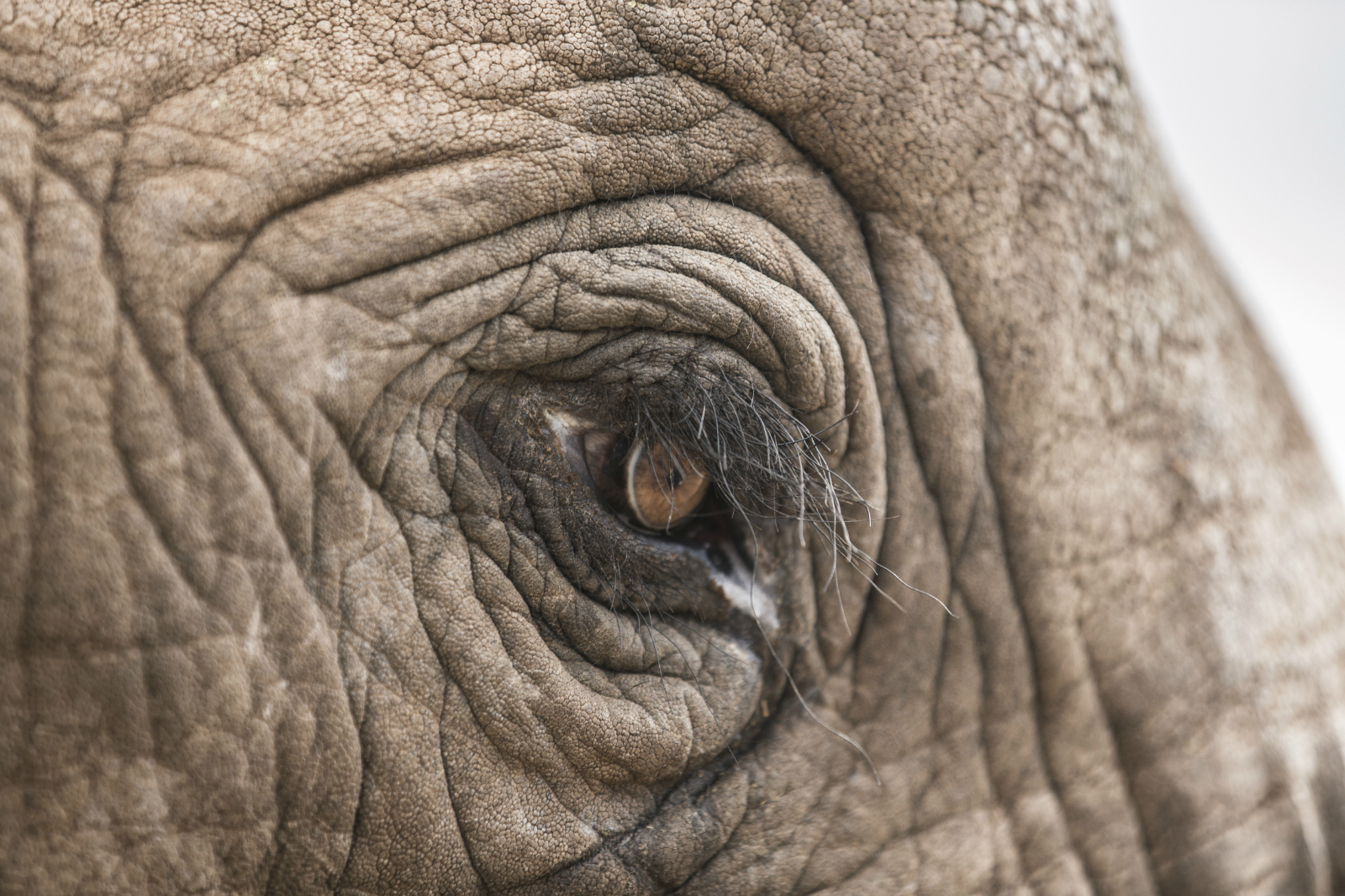
In 1800 there may have been 26 million elephants in Africa alone. Photograph: Graeme Robertson for the Guardian
“This is largely due to poaching,” says Chris Thouless, a conservationist who works with STE as a strategic adviser and who contributed to the status report. We meet over tea and home-baked cookies at his house overlooking the Borana private reserve, 10 minutes’ flying time south of Samburu.
Like diamonds and other valuable minerals, ivory is at the heart of a conflict over Africa’s natural resources; a war prosecuted by organised crime syndicates motivated by the enormous profits to be made from illegal poaching, smuggling and trading.
In the early years of this conflict, demand for ivory came mainly from Europe, America and Japan, fuelling a genocide that saw the African elephant population fall from a conservative estimate of 1.3 million in 1979 to less than half that within a decade. Some 700 tonnes of mostly illegal ivory – the equivalent of tusks from about 70,000 elephants – were leaving Africa each year, most of it heading for China to be processed and re-exported to markets elsewhere.
But in 1989, the Convention on International Trade in Endangered Species (Cites) banned ivory trading, and the next 15-20 years saw a hiatus in the elephant slaughter. The population showed incipient signs of recovery.
Ten years ago, however, the killing started again, this time stoked by rising demand in China itself as a result of its booming economy and its burgeoning moneyed elite. Now China is the end destination for 70% of illegal ivory; its price tripled between 2012 and 2014, reaching a peak of $2,200 (£1,675) per kilo.
It’s not like the battle has been won – the threat is still very real – but it’s not on the scale of a few years ago
In some countries the slaughter has reached an obliterative scale. Mozambique and Tanzania, both significant elephant countries, lost 53% and 60% of their elephants in just five years. In the Democratic Republic of the Congo, the elephant population has been almost eliminated. Central African Republic has lost almost all its savannah elephants. Sudan, Zimbabwe and Gabon are among countries that have seen widespread killing. Last year, some 20,000 elephants were being killed for their tusks in Africa – more than were born. In Asia, the other great homeland for elephants, it’s estimated that fewer than 50,000 remain, a decline of 50% in the past 100 years. The battle for the survival of the largest creatures currently roaming the earth is a long way from being won.
“A new optimism”
In Kenya however, some progress is being made. Koitelel was the last elephant known to have died at the hands of poachers in Samburu and the surrounding area, and conservationists hope that a corner has been turned in the past two years. “We are putting our hands together, hoping no more die,” says Leadismo. Douglas-Hamilton adds: “In Kenya, we have a new optimism. We’ve come through the eye of the storm – but that’s not the case across Africa.”
According to Thouless, “poaching is still a real issue, but [in Kenya] it’s under control. One doesn’t want to talk about acceptable levels of poaching, but poaching is no longer driving elephant levels down. It’s not like the battle has been won – the threat is still very real – but it’s not on the scale of a few years ago.”
And, he adds, although elephant killing is down in Kenya, the country is still a key component in the smuggling routes out of Africa to Asia. “Some of the biggest smuggling networks are based in Kenya. [The port of] Mombasa remains a huge suction point for ivory, particularly from Tanzania.”
There are a number of intertwined reasons why poaching has been contained in Kenya over the past two years. A key global factor is the slump in the price of raw ivory in China following an agreement signed jointly by the US and Chinese presidents in September 2014, pledging to end the ivory trade and as a result of the faltering Chinese economy. The price per kilo has fallen from $2,200 to $1,100 – although, says Thouless, it is still at a level “we’d have been horrified at five years ago” and “it hasn’t come down enough to act as a deterrent”.
But local changes have been hugely significant. The Kenyan government has shown a political will to act against poachers and enforce justice. In April, the Kenyan president, Uhuru Kenyatta, ceremonially burned more than 100 tonnes of extremely valuable ivory; in July, syndicate leader Feisal Mohamed Ali was sent to prison for 20 years and fined $200,000. Public opposition to the ivory trade has grown, and cooperation between conservationists and local communities has had a dramatic impact.
This last factor is crucial, says David Daballen. Persuading nomadic communities and local farmers of the merits of conservation has, he says, taken time. In nearby Nusuulu, where ivory poaching was rife a few years ago, it took a year to persuade elders from four tribes to come together and agree to create a conservation area on their land. “It means sitting under a tree for days and days and days – people talking, yelling, fighting – until sense prevails,” says Daballen.
Since the Nasuulu conservancy was created in 2011, large-scale elephant killing has stopped, security has improved and inter-tribe conflict has declined. A dozen or so local men are employed as rangers, scouts or drivers. Software is being developed to warn farmers when elephants are close so they can protect crops. STE has launched a scholarship programme for bright children in Nasuulu and other local conservancies. And, a mobile education unit leads classes and field trips to teach children how people and elephants can and should coexist in harmony.
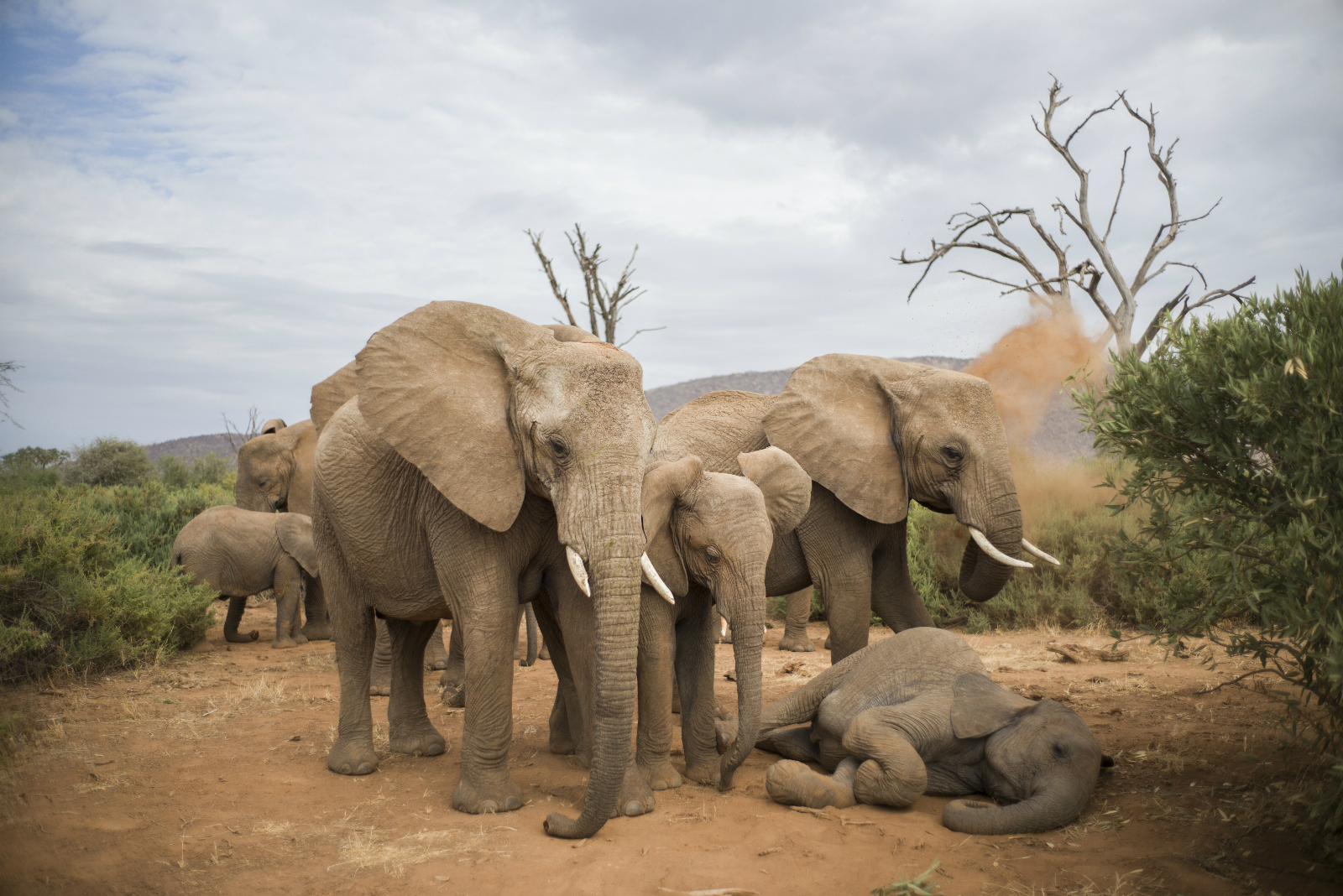
The illegal ivory trade has exploded despite the international ban on. Photograph: Graeme Robertson
On my last day we take to the air. Iain Douglas-Hamiliton settles in behind the controls of STE’s four-seater Cessna, trimmed with the family tartan, and gives the plane’s call sign – “five yankee sierra tango echo” – to other pilots who might be in the sky. In less than a minute we’re airborne over Samburu and the neighbouring reserve, Buffalo Springs, scanning the savannah below for elephants.
The plane is used to monitor and track elephants in a complementary operation to the ground excursions. In Samburu, 60 elephants have been tranquillised – in often difficult circumstances – to allow loose collars with GPS devices to be fitted, making these northern Kenyan elephants the most closely monitored in Africa. The signal is beamed to a satellite and back to STE’s research camp, giving regularly updated locations for the elephants which are transmitted via an app to the staff’s phones and tablets.
But Douglas-Hamilton has accidentally left his phone on the ground, so we are freewheeling over the savannah, relying on our eyes. He points out an area vacated by a group of nomads to allow the elephants free range. “These sorts of compromises are essential between elephant and man,” he says. When we spot a group of elephants, Douglas-Hamilton executes a stomach-heaving turn to get a closer look. He wants to note where they are, how many are in the group, which family it is, how close they are to water, livestock and people.
At 74, Douglas-Hamilton has devoted his life to elephants. After studying zoology at Oxford he moved to Tanzania, and later to Kenya. In the 1970s and 80s, he began aerial surveys of Africa’s elephant population, revealing the shocking scale of poaching. He founded Save the Elephants in 1993.
“I’ve focussed on elephants all my working life. But you also have to get deeply interested in politics, community issues, human welfare – because man is the most important determinant of the elephant’s future,” he says. Ensuring a future for elephants and their environment means creating positive co-existence between humans and elephants – and this will become increasingly important with the exponential growth of the human population across the continent, which is expected to double to 2.5 billion between now and 2050.
His brother-in-arms Thouless also expounds on the relationship between the growing population and economies of African countries and its wildlife. As conservationists, he says: “We may have to curb our ambitions. It’s not just the increased number of people, it’s also the increased footprint of those people as you get economic development. Poaching dominates our thoughts, but the implications of plans for transcontinental railways, roads and pipelines are massive.
Elephants have a humbling effect on humans; they make us realise that perhaps we are not the masters of the universe
“It may be unrealistic to expect vast untrammelled landscapes across which elephants can move freely. We’re going to have to accept losses as a result of infrastructure changes, and choose our battles.”
But, he says, the elephants must be saved. “They are part of the planet’s natural heritage. If you’d never seen an elephant, and encountered one, you’d think it was absolutely amazing, like a dinosaur. They are a window into our past. But they also have a humbling effect on humans; they make us realise that perhaps we are not the masters of the universe.”
In the Cessna, circling high above the savannah and gazing down on its extraordinary and complex ecosystem, I do indeed feel humbled: a speck of insignificance in the enormity and wonder of nature. Below us are elephants, lions, giraffe, cheetahs, zebra, crocodiles, hyenas, baboons, impala and dozens of other awe-inspiring species, many of them threatened by the actions and demands of humans.
Swinging the plane back towards to rough airstrip at Buffalo Springs, Douglas-Hamilton cautions against hyperbole, instead urging rigorous data gathering and analysis. “Elephants are resilient and wily, they are good survivors and are adaptable. Despite all the pressures and dangers, I don’t think all elephants will be lost within a generation, I don’t see extinction. What’s likely to happen is their removal from vast tracks of their current range.”
But, he adds, the threat to elephants is part of a much bigger catastrophe which cannot be averted without “active collaboration from a wide range of actors and activists – local populations, scientists, civic groups, corporations, politicians, security forces.
“The degradation of the environment through grotesquely irresponsible human behaviour is a terrible thing. We’re in danger of throwing away three billion years of evolution.”
Vulcan, who ran the Great Elephant Census, also supports this independent editorial series.
Over the coming year, the Guardian with the support of China Dialogue will report on efforts to stop the decline of elephant. See here for an introduction to the series and explanation of why the Guardian is publishing its elephant reporting in Chinese.
